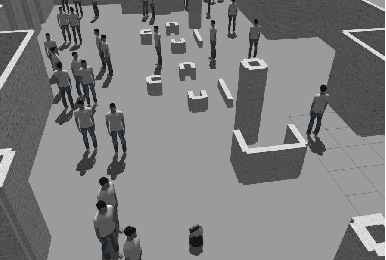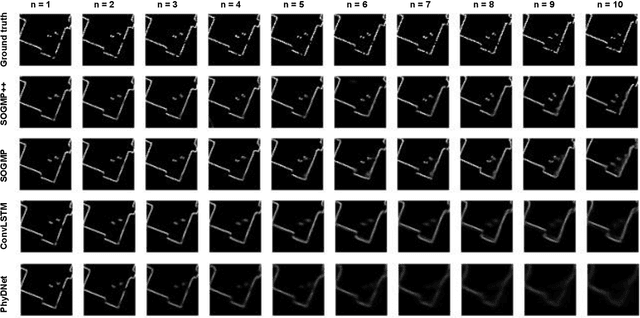Philip Dames
Energy Efficient Multi Robot Package Delivery under Capacity-Constraints via Voronoi-Constrained Networks
Sep 17, 2025Abstract:We consider the problem of delivering multiple packages from a single pickup depot to distinct goal locations using a homogeneous fleet of robots with limited carrying capacity. We propose VCST-RCP, a Voronoi-Constrained Steiner Tree Relay Coordination Planning framework that constructs sparse relay trunks using Steiner tree optimization and then synthesizes robot-level pickup, relay, and delivery schedules. This framework reframes relays from incidental byproducts into central elements of coordination, offering a contrast with traditional delivery methods that rely on direct source-to-destination transport. Extensive experiments show consistent improvements of up to 34% compared to conventional baselines, underscoring the benefits of incorporating relays into the delivery process. These improvements translate directly to enhanced energy efficiency in multi-robot delivery under capacity constraints, providing a scalable framework for real-world logistics.
DELIVER: A System for LLM-Guided Coordinated Multi-Robot Pickup and Delivery using Voronoi-Based Relay Planning
Aug 26, 2025Abstract:We present DELIVER (Directed Execution of Language-instructed Item Via Engineered Relay), a fully integrated framework for cooperative multi-robot pickup and delivery driven by natural language commands. DELIVER unifies natural language understanding, spatial decomposition, relay planning, and motion execution to enable scalable, collision-free coordination in real-world settings. Given a spoken or written instruction, a lightweight instance of LLaMA3 interprets the command to extract pickup and delivery locations. The environment is partitioned using a Voronoi tessellation to define robot-specific operating regions. Robots then compute optimal relay points along shared boundaries and coordinate handoffs. A finite-state machine governs each robot's behavior, enabling robust execution. We implement DELIVER on the MultiTRAIL simulation platform and validate it in both ROS2-based Gazebo simulations and real-world hardware using TurtleBot3 robots. Empirical results show that DELIVER maintains consistent mission cost across varying team sizes while reducing per-agent workload by up to 55% compared to a single-agent system. Moreover, the number of active relay agents remains low even as team size increases, demonstrating the system's scalability and efficient agent utilization. These findings underscore DELIVER's modular and extensible architecture for language-guided multi-robot coordination, advancing the frontiers of cyber-physical system integration.
Semantic2D: A Semantic Dataset for 2D Lidar Semantic Segmentation
Sep 15, 2024Abstract:This paper presents a 2D lidar semantic segmentation dataset to enhance the semantic scene understanding for mobile robots in different indoor robotics applications. While most existing lidar semantic datasets focus on 3D lidar sensors and autonomous driving scenarios, the proposed 2D lidar semantic dataset is the first public dataset for 2D lidar sensors and mobile robots. It contains data collected in six different indoor environments and has nine categories of typical objects in indoor environments. A novel semi-automatic semantic labeling framework is proposed to provide point-wise annotation for the dataset with minimal human effort. Based on this 2D lidar dataset, a hardware-friendly stochastic semantic segmentation benchmark is proposed to enable 2D lidar sensors to have semantic scene understanding capabilities. A series of segmentation tests are performed to demonstrate that the proposed learning-based segmentation benchmark can achieve more accurate and richer segmentation for each lidar point compared to traditional geometry-based extraction algorithms.
Speech-Guided Sequential Planning for Autonomous Navigation using Large Language Model Meta AI 3 (Llama3)
Jul 13, 2024Abstract:In social robotics, a pivotal focus is enabling robots to engage with humans in a more natural and seamless manner. The emergence of advanced large language models (LLMs) such as Generative Pre-trained Transformers (GPTs) and autoregressive models like Large Language Model Meta AI (Llamas) has driven significant advancements in integrating natural language understanding capabilities into social robots. This paper presents a system for speech-guided sequential planning in autonomous navigation, utilizing Llama3 and the Robot Operating System~(ROS). The proposed system involves using Llama3 to interpret voice commands, extracting essential details through parsing, and decoding these commands into sequential actions for tasks. Such sequential planning is essential in various domains, particularly in the pickup and delivery of an object. Once a sequential navigation task is evaluated, we employ DRL-VO, a learning-based control policy that allows a robot to autonomously navigate through social spaces with static infrastructure and (crowds of) people. We demonstrate the effectiveness of the system in simulation experiment using Turtlebot 2 in ROS1 and Turtlebot 3 in ROS2. We conduct hardware trials using a Clearpath Robotics Jackal UGV, highlighting its potential for real-world deployment in scenarios requiring flexible and interactive robotic behaviors.
SCOPE: Stochastic Cartographic Occupancy Prediction Engine for Uncertainty-Aware Dynamic Navigation
Jun 28, 2024Abstract:This article presents a family of Stochastic Cartographic Occupancy Prediction Engines (SCOPEs) that enable mobile robots to predict the future states of complex dynamic environments. They do this by accounting for the motion of the robot itself, the motion of dynamic objects, and the geometry of static objects in the scene, and they generate a range of possible future states of the environment. These prediction algorithms are software-optimized for real-time performance for navigation in crowded dynamic scenes, achieving 10 times faster inference speed and 3 times less memory usage than the original engines. Three simulated and real-world datasets collected by different robot models are used to demonstrate that these proposed prediction algorithms are able to achieve more accurate and robust stochastic prediction performance than other algorithms. Furthermore, a series of simulation and hardware navigation experiments demonstrate that the proposed predictive uncertainty-aware navigation framework with these stochastic prediction engines is able to improve the safe navigation performance of current state-of-the-art model- and learning-based control policies.
Towards Predicting Collective Performance in Multi-Robot Teams
May 02, 2024



Abstract:The increased deployment of multi-robot systems (MRS) in various fields has led to the need for analysis of system-level performance. However, creating consistent metrics for MRS is challenging due to the wide range of system and environmental factors, such as team size and environment size. This paper presents a new analytical framework for MRS based on dimensionless variable analysis, a mathematical technique typically used to simplify complex physical systems. This approach effectively condenses the complex parameters influencing MRS performance into a manageable set of dimensionless variables. We form dimensionless variables which encapsulate key parameters of the robot team and task. Then we use these dimensionless variables to fit a parametric model of team performance. Our model successfully identifies critical performance determinants and their interdependencies, providing insight for MRS design and optimization. The application of dimensionless variable analysis to MRS offers a promising method for MRS analysis that effectively reduces complexity, enhances comprehension of system behaviors, and informs the design and management of future MRS deployments.
Splat-Nav: Safe Real-Time Robot Navigation in Gaussian Splatting Maps
Mar 05, 2024Abstract:We present Splat-Nav, a navigation pipeline that consists of a real-time safe planning module and a robust state estimation module designed to operate in the Gaussian Splatting (GSplat) environment representation, a popular emerging 3D scene representation from computer vision. We formulate rigorous collision constraints that can be computed quickly to build a guaranteed-safe polytope corridor through the map. We then optimize a B-spline trajectory through this corridor. We also develop a real-time, robust state estimation module by interpreting the GSplat representation as a point cloud. The module enables the robot to localize its global pose with zero prior knowledge from RGB-D images using point cloud alignment, and then track its own pose as it moves through the scene from RGB images using image-to-point cloud localization. We also incorporate semantics into the GSplat in order to obtain better images for localization. All of these modules operate mainly on CPU, freeing up GPU resources for tasks like real-time scene reconstruction. We demonstrate the safety and robustness of our pipeline in both simulation and hardware, where we show re-planning at 5 Hz and pose estimation at 20 Hz, an order of magnitude faster than Neural Radiance Field (NeRF)-based navigation methods, thereby enabling real-time navigation.
Distributed Multi-Robot Multi-Target Tracking Using Heterogeneous Limited-Range Sensors
Nov 03, 2023



Abstract:This paper presents a cooperative multi-robot multi-target tracking framework aimed at enhancing the efficiency of the heterogeneous sensor network and, consequently, improving overall target tracking accuracy. The concept of normalized unused sensing capacity is introduced to quantify the information a sensor is currently gathering relative to its theoretical maximum. This measurement can be computed using entirely local information and is applicable to various sensor models, distinguishing it from previous literature on the subject. It is then utilized to develop a distributed coverage control strategy for a heterogeneous sensor network, adaptively balancing the workload based on each sensor's current unused capacity. The algorithm is validated through a series of ROS and MATLAB simulations, demonstrating superior results compared to standard approaches that do not account for heterogeneity or current usage rates.
DRL-VO: Learning to Navigate Through Crowded Dynamic Scenes Using Velocity Obstacles
Jan 16, 2023Abstract:This paper proposes a novel learning-based control policy with strong generalizability to new environments that enables a mobile robot to navigate autonomously through spaces filled with both static obstacles and dense crowds of pedestrians. The policy uses a unique combination of input data to generate the desired steering angle and forward velocity: a short history of lidar data, kinematic data about nearby pedestrians, and a sub-goal point. The policy is trained in a reinforcement learning setting using a reward function that contains a novel term based on velocity obstacles to guide the robot to actively avoid pedestrians and move towards the goal. Through a series of 3D simulated experiments with up to 55 pedestrians, this control policy is able to achieve a better balance between collision avoidance and speed (i.e. higher success rate and faster average speed) than state-of-the-art model-based and learning-based policies, and it also generalizes better to different crowd sizes and unseen environments. An extensive series of hardware experiments demonstrate the ability of this policy to directly work in different real-world environments with different crowd sizes with zero retraining. Furthermore, a series of simulated and hardware experiments show that the control policy also works in highly constrained static environments on a different robot platform without any additional training. Lastly, we summarize several important lessons that can be applied to other robot learning systems. Multimedia demonstrations are available at https://www.youtube.com/watch?v=eCcNYSbgCv8&list=PLouWbAcP4zIvPgaARrV223lf2eiSR-eSS.
Stochastic Occupancy Grid Map Prediction in Dynamic Scenes
Oct 16, 2022



Abstract:This paper presents two variations of a novel stochastic prediction algorithm that enables mobile robots to accurately and robustly predict the future state of complex dynamic scenes, such as environments full of people. The proposed algorithm uses a variational autoencoder-based neural network to predict a range of possible future states of the environment. The algorithm takes full advantage of the motion of the robot itself, the motion of dynamic objects, and the geometry of static objects in the scene to improve prediction accuracy. Three different datasets collected by different robot models are used to demonstrate that the proposed algorithm is able to achieve smaller absolute error, higher structure similarity, and higher tracking accuracy than state-of-the-art prediction algorithms for video prediction tasks. Implementations of both proposed stochastic prediction algorithms are available open source at https://github.com/TempleRAIL/SOGMP.
 Add to Chrome
Add to Chrome Add to Firefox
Add to Firefox Add to Edge
Add to Edge